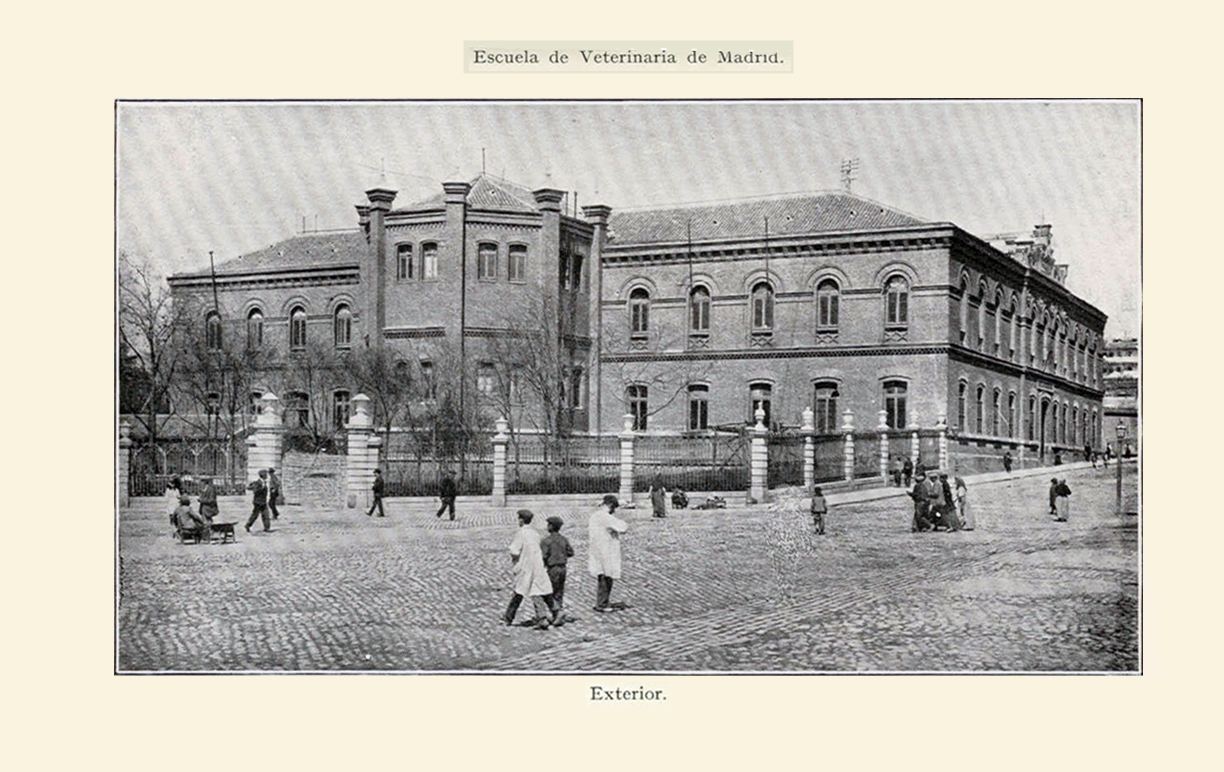Historia
Historia
La actual Facultad de Veterinaria, ubicada en el campus complutense, es heredera de instituciones muy antiguas que tuvieron su origen en la actividad veterinaria medieval, organizada en los primeros gremios de albéitares (“cuidadores de los animales”, en árabe). Así, el Real Tribunal del Protoalbeiterato del s. XV, dió paso a la primera escuela de veterinaria creada en España en el año 1793, el Real Colegio - Escuela de Veterinaria de Madrid, con una enseñanza reglada basada en criterios científicos y técnicos. El Real Colegio estaba situado en el convento de los Agustinos Descalzos Recoletos, lo que hoy es la Biblioteca Nacional y tuvo inicialmente carácter militar hasta 1840, conviviendo con el Real Tribunal del Protoalbeiterato hasta la supresión oficial de éste por el decreto de 1847. La institución sufrió los efectos de guerras y expolios y con el posterior deterioro fue trasladada en el curso 1862-63 a un edificio de la carrera de San Francisco nº 13. Duró poco en esta sede y ocupó en 1877 un edificio cercano a la Ronda de Toledo, en el denominado Casino de la Reina. No sería hasta 1882 cuando fue trasladada de nuevo a una sede mejor dotada, como fue la Escuela de Veterinaria de la Glorieta de Embajadores, actual IES Cervantes, cuyo proyecto fue realizado por el prestigioso arquitecto Francisco Jareño de Alarcón.
En 1958, el anhelo de incorporarse con los demás estudios en la Ciudad Universitaria y el deterioro de las instalaciones llevaron al cierre de la sede de Embajadores. Tras unas considerables vicisitudes, como fueron la impartición de la docencia en aulas de la Facultad de Derecho y en instalaciones provisionales en la parte baja del solar de Puerta de Hierro, se abrió la actual sede en su emplazamiento de la Avenida Puerta de Hierro s/n en el curso 1968-69.
Los estudios de Veterinaria adquieren el rango de licenciatura en 1943 por Ley de Ordenación Universitaria y en 1944 se posibilita la colación del título de Doctor. Sus instalaciones se han ido ampliando con nuevos aularios, Granja Docente, Planta Piloto de Tecnología de Alimentos y, en especial, con el Hospital Clínico Veterinario Complutense, abierto en 1996.
El recorrido histórico del Centro desde sus orígenes queda plasmado en las piezas y objetos que alberga el actual Museo Veterinario Complutense donde a través de los modelos, preparaciones, instrumental y patrimonio institucional puede comprobarse cómo la veterinaria como ciencia y profesión ha ido evolucionando y adaptando su docencia. Así, esta disciplina comprende, por ejemplo, la medicina animal, la seguridad y calidad alimentaria, la salud pública, la producción animal y el medio ambiente. De modo paralelo, la docencia, la investigación y las instalaciones del centro han ido adaptándose a estas nuevas necesidades de formación, con la adecuación a los nuevos Grados y siendo evaluada positivamente por agencias de acreditación europeas (EAEVE) en el ámbito veterinario.
The current Faculty of Veterinary Medicine, located on the Complutense campus, is the successor of very ancient institutions that originated from medieval veterinary activities, organized in the first guilds of albéitares ("animal caretakers" in Arabic). Thus, the Royal Tribunal of Protoalbeiterato of the 15th century, gave way to the first veterinary school created in Spain in 1793, the Royal School of Veterinary Medicine of Madrid, with formal education based on scientific and technical criteria. The Royal College was located in the convent of the Augustinian Recollects, which today is the National Library, and initially had a military character until 1840, coexisting with the Royal Tribunal of Protoalbeiterato until its official suppression by the decree of 1847. The institution suffered the effects of wars and looting and with subsequent deterioration, it was moved in the course of 1862-63 to a building on San Francisco street No. 13. It did not last long in this location and in 1877 occupied a building near Ronda de Toledo, in the so-called Casino de la Reina. It was not until 1882 when it was moved again to a better-equipped headquarters, such as the School of Veterinary Medicine at Glorieta de Embajadores, currently IES Cervantes, whose project was carried out by the prestigious architect Francisco Jareño de Alarcón.
In 1958, the desire to join the other studies in the University City and the deterioration of the facilities led to the closure of the Embajadores headquarters. After considerable vicissitudes, such as teaching in classrooms of the Faculty of Law and in provisional facilities in the lower part of the Puerta de Hierro site, the current headquarters opened in its location at Avenida Puerta de Hierro s/n in the 1968-69 academic year.
Veterinary studies acquired the rank of a degree in 1943 by the University Organization Law and in 1944 the awarding of the Doctorate title was made possible. Its facilities have been expanded with new classrooms, a Teaching Farm, a Pilot Plant for Food Technology, and especially with the Complutense Veterinary Clinical Hospital, opened in 1996.
The historical journey of the Center from its origins is reflected in the pieces and objects housed in the current Complutense Veterinary Museum where, through models, preparations, instruments, and institutional heritage, it can be seen how veterinary science and profession have evolved and adapted their teaching. Thus, this discipline includes, for example, animal medicine, food safety and quality, public health, animal production, and the environment. In parallel, the teaching, research, and facilities of the center have adapted to these new training needs, adjusting to the new Degrees and being positively evaluated by European accreditation agencies (EAEVE) in the veterinary field.
Imagen de la Escuela de Veterinaria de Embajadores (cerca de 1890)

